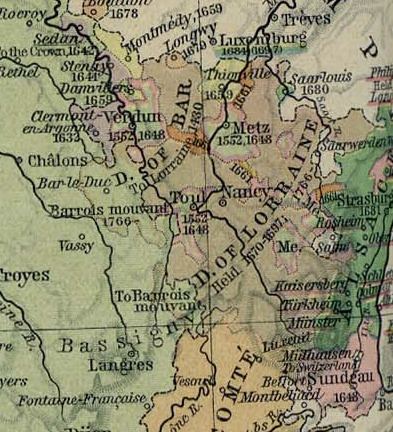Capital Verdun Historical era Middle Ages Date dissolved 1552 | Government Theocracy Preceded by Succeeded by | |
 | ||
Bishopric of verdun
The Bishopric of Verdun was also a state of the Holy Roman Empire; it was located at the western edge of the Empire and was bordered by France, the Duchy of Luxembourg, and the Duchy of Bar.
Contents
- Bishopric of verdun
- History
- Fourth century
- Fifth century
- Sixth century
- Seventh century
- Eighth century
- Ninth century
- Tenth century
- Eleventh century
- Twelfth century
- Thirteenth century
- Fourteenth century
- Fifteenth century
- Sixteenth century
- Seventeenth century
- Eighteenth century
- References
History
This fief also included the advowson of the church of Verdun over its possessions along the river Moselle. According to a chronist’s report, written around the year 900, the Merovingian king Childebert II (575–596) came to visit Verdun. There was not enough wine to serve the monarch and the Bishop Agericus was very embarrassed. However God rewarded him for his good deeds and miraculously increased the amount of wine. The king presented Agericus of Verdun with the Schloss Veldenz as a fief of Verdun "because of the wine". Around 1156 Frederick Barbarossa confirmed the holding by Bishop Albert I of Verdun of the castle together with the surrounding land.
A story that Peter (774-798), successor of Madalvaeus, was granted temporal lordship of the Diocese by Charlemagne, but this is no longer accepted.
Because of the destruction of the archives in a fire Bishop Dadon (880-923) commissioned the Gesta episcoporum Virodunensium (Chronicle of the Bishops of Verdun) from Bertharius, a Benedictine monk. This was continued to 1250 by a second monk, Lawrence, and later by an anonymous writer.
A key element of Emperor Otto I's domestic policy was to strengthen ecclesiastical authorities at the expense of the nobility who threatened his power. To this end he filled the ranks of the episcopate with his own relatives and with loyal chancery clerks. As protector of the Church he invested them with the symbols of their offices, both spiritual and secular, so the clerics were appointed as his vassals through a commendation ceremony. Historian Norman Cantor concludes: "Under these conditions clerical election became a mere formality in the Ottonian empire ..." The Bishop of Verdun, appointed by Otto, was totally faithful to the emperor.
In 990 Bishop Haimont ordered the construction of a new cathedral on the Romano-Rhenish plan: a nave, two transepts, two opposing apses, each one flanked by two bell towers. The Holy Roman Emperor Otto III bestowed the title Count on Bishop Haimont (990-1024) and his successors in 997. The bishops had the right to appoint a temporary "count for life" (comte viager), theoretically subject to the authority of the bishop. These counts were selected from the noble family of Ardennes. There was frequent conflict between the count and the bishop.
With the marriage of Philip IV with Joan I of Navarre, the daughter of the Count of Champagne, Lorraine and particularly Verdun become a primary focus for the crown of France. After 1331, appointment to the episcopal see was controlled by the King of France rather than the Emperor.
The Bishopric was annexed to France in 1552; this was recognized by the Holy Roman Empire in the Peace of Westphalia of 1648. It then was a part of the province of the Three Bishoprics.
Fourth century
Fifth century
Sixth century
Seventh century
Eighth century
Ninth century
Tenth century
Eleventh century
Twelfth century
Thirteenth century
Fourteenth century
Fifteenth century
Sixteenth century
Seventeenth century
Eighteenth century
Until 1801 Verdun was part of the ecclesiastical province of the Archbishop of Trier. On November 29, 1801 it was suppressed and added to the Diocese of Nancy. On October 6, 1822 the diocese was re-established.
